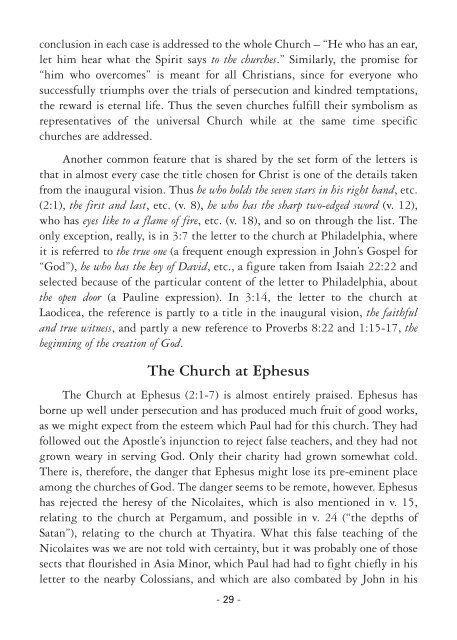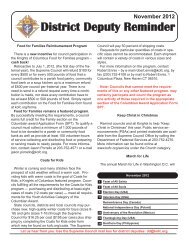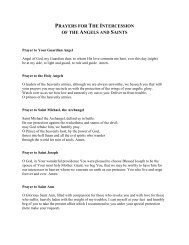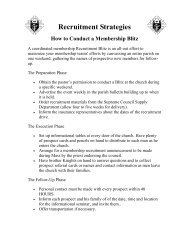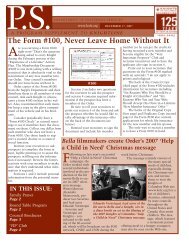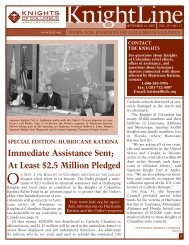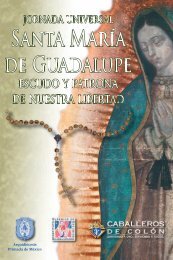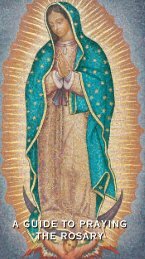Revelation: - Knights of Columbus, Supreme Council
Revelation: - Knights of Columbus, Supreme Council
Revelation: - Knights of Columbus, Supreme Council
You also want an ePaper? Increase the reach of your titles
YUMPU automatically turns print PDFs into web optimized ePapers that Google loves.
conclusion in each case is addressed to the whole Church – “He who has an ear,<br />
let him hear what the Spirit says to the churches.” Similarly, the promise for<br />
“him who overcomes” is meant for all Christians, since for everyone who<br />
successfully triumphs over the trials <strong>of</strong> persecution and kindred temptations,<br />
the reward is eternal life. Thus the seven churches fulfill their symbolism as<br />
representatives <strong>of</strong> the universal Church while at the same time specific<br />
churches are ad dressed.<br />
Another common feature that is shared by the set form <strong>of</strong> the let ters is<br />
that in almost every case the title chosen for Christ is one <strong>of</strong> the details taken<br />
from the in augural vision. Thus he who holds the seven stars in his right hand, etc.<br />
(2:1), the first and last, etc. (v. 8), he who has the sharp two-edged sword (v. 12),<br />
who has eyes like to a flame <strong>of</strong> fire, etc. (v. 18), and so on through the list. The<br />
only exception, really, is in 3:7 the letter to the church at Philadelphia, where<br />
it is referred to the true one (a frequent enough expression in John’s Gospel for<br />
“God”), he who has the key <strong>of</strong> David, etc., a figure taken from Isaiah 22:22 and<br />
selected because <strong>of</strong> the particular content <strong>of</strong> the letter to Philadelphia, about<br />
the open door (a Pauline expression). In 3:14, the letter to the church at<br />
Laodicea, the reference is partly to a title in the inaugural vision, the faithful<br />
and true witness, and partly a new reference to Proverbs 8:22 and 1:15-17, the<br />
beginning <strong>of</strong> the creation <strong>of</strong> God.<br />
The Church at Ephesus<br />
The Church at Ephesus (2:1-7) is almost entirely praised. Ephesus has<br />
borne up well under persecu tion and has produced much fruit <strong>of</strong> good works,<br />
as we might expect from the esteem which Paul had for this church. They had<br />
followed out the Apostle’s injunction to re ject false teachers, and they had not<br />
grown weary in serving God. Only their charity had grown some what cold.<br />
There is, therefore, the danger that Ephesus might lose its pre-eminent place<br />
among the churches <strong>of</strong> God. The danger seems to be remote, however. Ephesus<br />
has rejected the heresy <strong>of</strong> the Nicolaites, which is also mentioned in v. 15,<br />
relating to the church at Pergamum, and possible in v. 24 (“the depths <strong>of</strong><br />
Satan”), relating to the church at Thyatira. What this false teach ing <strong>of</strong> the<br />
Nicolaites was we are not told with certainty, but it was probably one <strong>of</strong> those<br />
sects that flourished in Asia Minor, which Paul had had to fight chiefly in his<br />
letter to the nearby Colossians, and which are also combated by John in his<br />
- 29 -


